Reading time 8 minutes.
Hampi, our second to last destination in India, is a UNESCO World Heritage Site in the Karnataka state.
We took the train from Vasco da Gama (Goa) to Hosapete (the closest town with a train station). The train was scheduled to depart at 6:30 am and arrived around 4 pm. It was early morning, the public buses start at 7 am, so we took the taxi booked by the hotel (500 rupees or 5.46 euros).
Tiger the Driver
Our accommodation was in Kadirampuram, a village located a few kilometers away from the archeological sites. We were quite surprised to discover many drivers were familiar with French. We hired a tuktuk from Hosapete to Kadirampuram and negotiated the fare down from 300 to 200 rupees. His name was Tiger. Actually, Shiva was his first name and Tiger his second name. After he dropped us in front of the guest house, he tried to sell us his touristic tour for the same day and/or the next day (9 am to 7 pm for 1500 rupees, 16.37 euros).
In the evening, we negotiated the tour for 1300 rupees on WhatsApp. We were in contact with one of Tiger’s friends because he had such an old phone. Eventually, we paid him 1500 because the tour was great.
Tiger spoke English well and provided us with interesting context before each temple. We visited mostly temples.
Alternatives to the tuktuk driver
Here are the main alternatives to hiring a tuktuk driver:
- Hiring a taxi driver. We met a British couple who came with their driver from Gao for 2 days in Hampi. This option probably cost 2,000–4,000 rupees per day, expensive.
- Renting a car. I haven’t explored this option.
- Renting a scooter/motorcycle is a popular option. Prices are reasonable, 600–700 rupees (6.53-7.62 euros). You can try to negotiate them for 500. Traffic is smooth around Hampi. Scooters might be scarce, you could need to rent them the day before or wake up early the same day to secure them. You need an international driving license as a foreigner.
- Taking different tuktuks for each ride. We considered it, but there are a few caveats with that approach:
- Tuktuks are not available at every archeological site. Even if you see a few of them, they are probably already hired for the day. You might end up walking more than expected.
- You spend quite some time waiting and negotiating with tuktuks, which is not enjoyable.
- It might not be so cheap if every independent ride cost you around 200 rupees. It is a cheap option only if you walk a lot.
- Renting bicycles. I saw a few foreign tourists on bicycles. You can rent the most basic you can think of (City Cycle Btwin My Bike?) for 200 rupees a day, better bicycles cost 300–350 rupees a day. If you are two people, you require only one scooter but two bikes. The distances are not very long, but since it’s hilly and hot (and polluted), and renting a bicycle is not very cost-effective compared to a motorcycle, I would recommend the motorcycle.
- Organized day trip to Hampi on a coach bus.
The owner of the guest house was so nice, even if we could barely communicate. First, he drove me to a place to rent bicycles, then to the neighboring village to rent a scooter. Given the countries we were planning to visit, we did not think we would drive for safety reasons, so we did not ask for international driving licenses. We probably should have. Now that we travel, getting it (from Quebec) is still possible but more difficult.
Ask for your international driving license before you leave. You never know when you will want to make use of it.
Archeological Sites
Many archeological sites in Hampi are temples, some of which are still active today.
You need a single ticket for all the monuments. It is slightly cheaper to book online. Security personnel were not equipped to scan online tickets. They just looked at the digital ticket for check up.
Vitthala Temple
We started the tour with Vitthala Temple, one of the most important complex in Hampi. From the entrance, you can either walk or take an electric shuttle for 20 rupees (round-trip price).
The temple is beautifully preserved. Inside the walls, there are a stone chariot pushed by elephants in the middle, the main building behind it, and 2 minor buildings on the sides. The chariot is a shrine dedicated to Garuda, a deity and the mount/vehicle of Vishnu. Musical pillars, located in the main building, are like drums, they resonate and propagate a variety of sounds. To listen to them, place your ears on the opposite side of the column. However, they are no longer accessible. Were they damaged by brute visitors? You can walk, almost in the dark, around the base of the highest construction of the temple. The complex is large, after the temple, head to the river and enjoy the view.
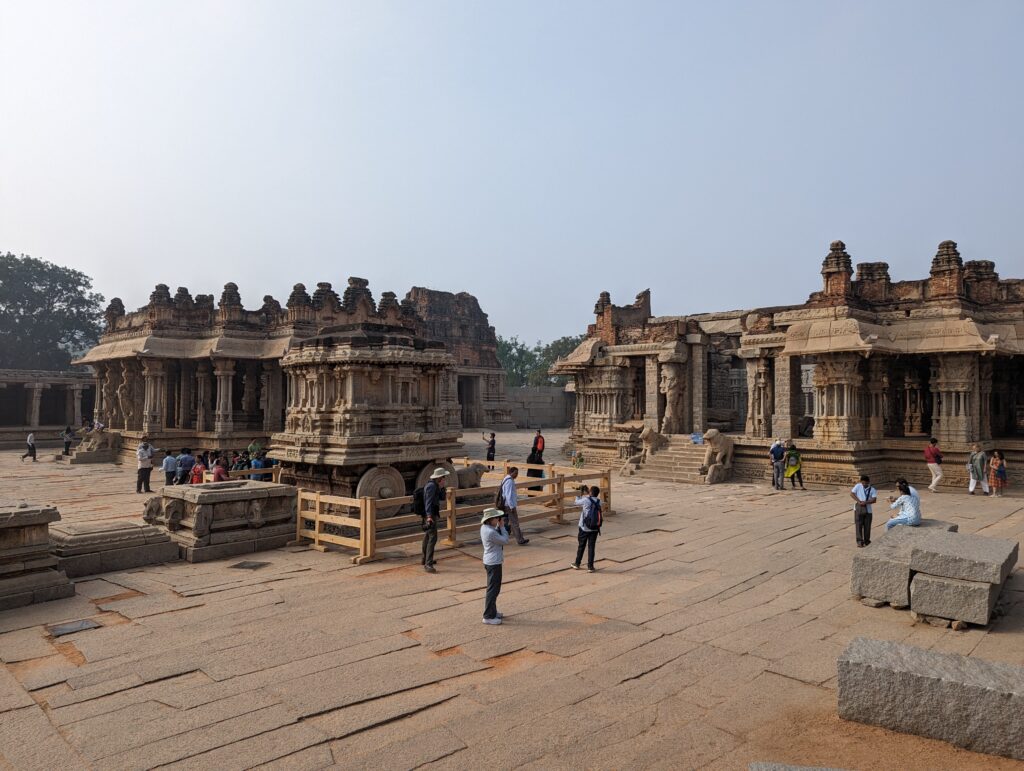
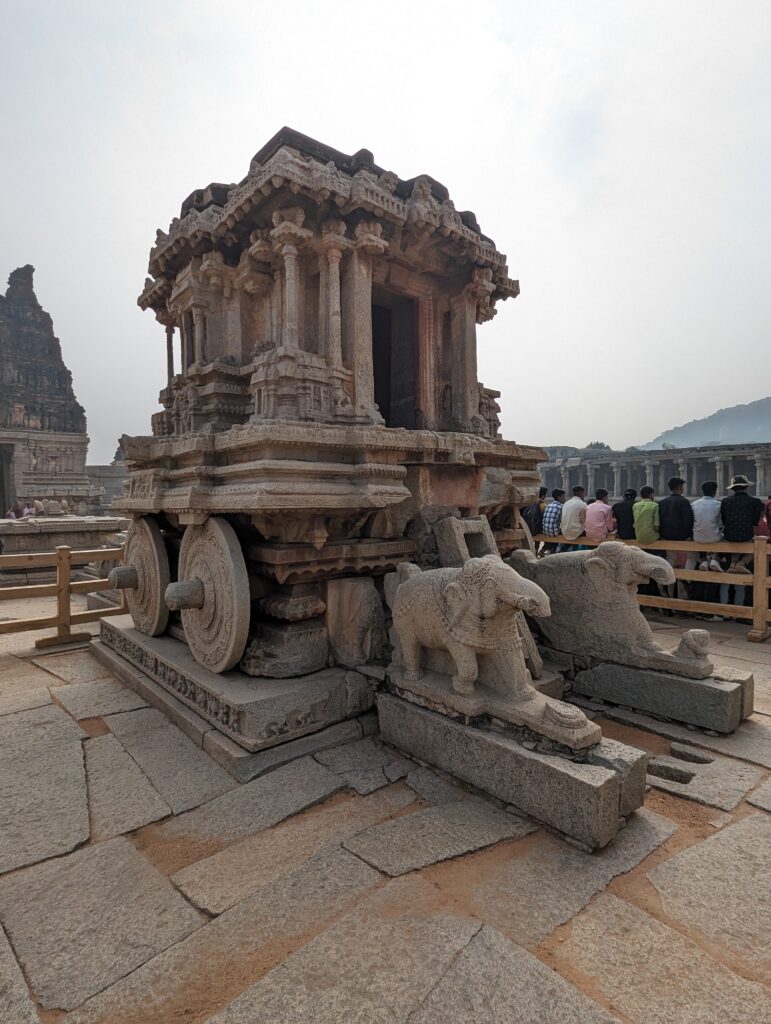

Boulder Temples Complex
Malyvanta Raghunata Temple is built on a site where many boulders can be found. Hampi is actually a popular destination for outdoor bouldering. If only I had more time there!
Tiger took so many pictures of us, he knew where were the good spots.
He showed us how the musical pillars worked, impressive!
Many pilgrims were there. Apparently, their goal is to reach the Hanuman temple — we saw it previously by the river — on top of a mountain. They were going to stop at every village along the way for approximately a month.
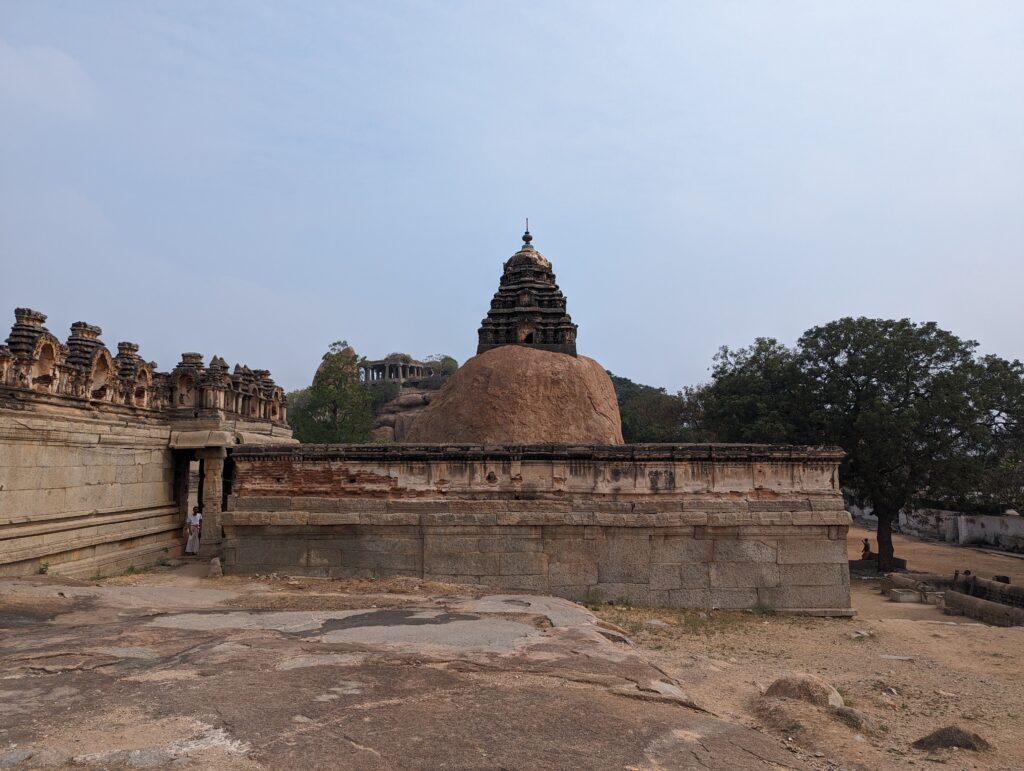
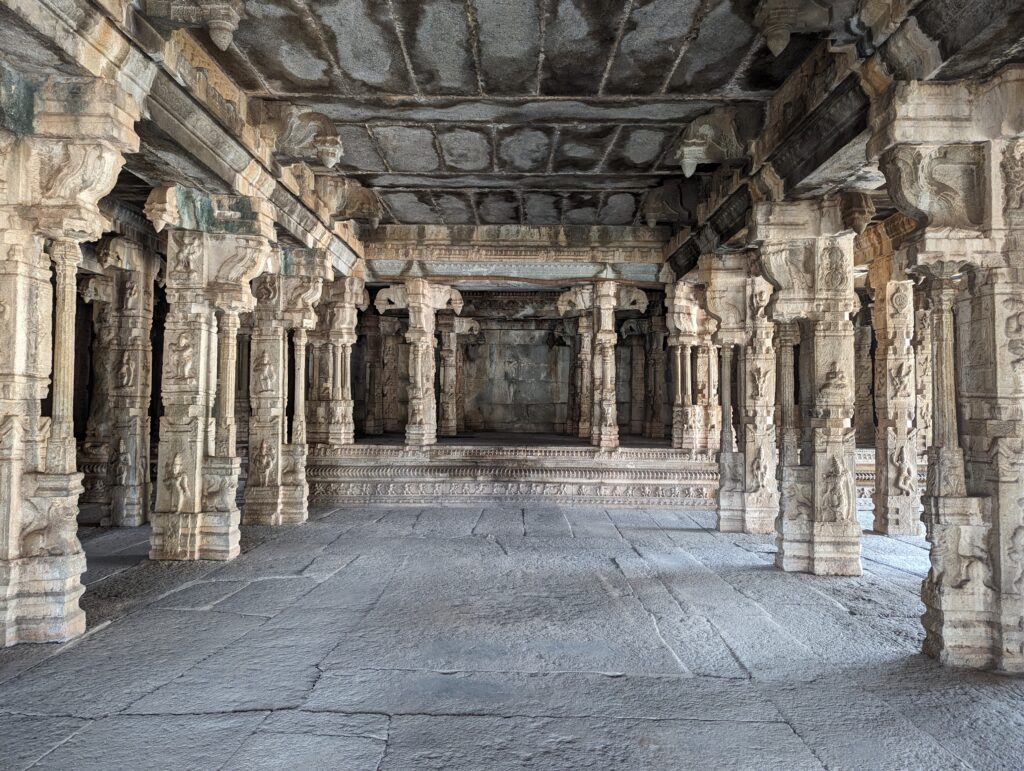
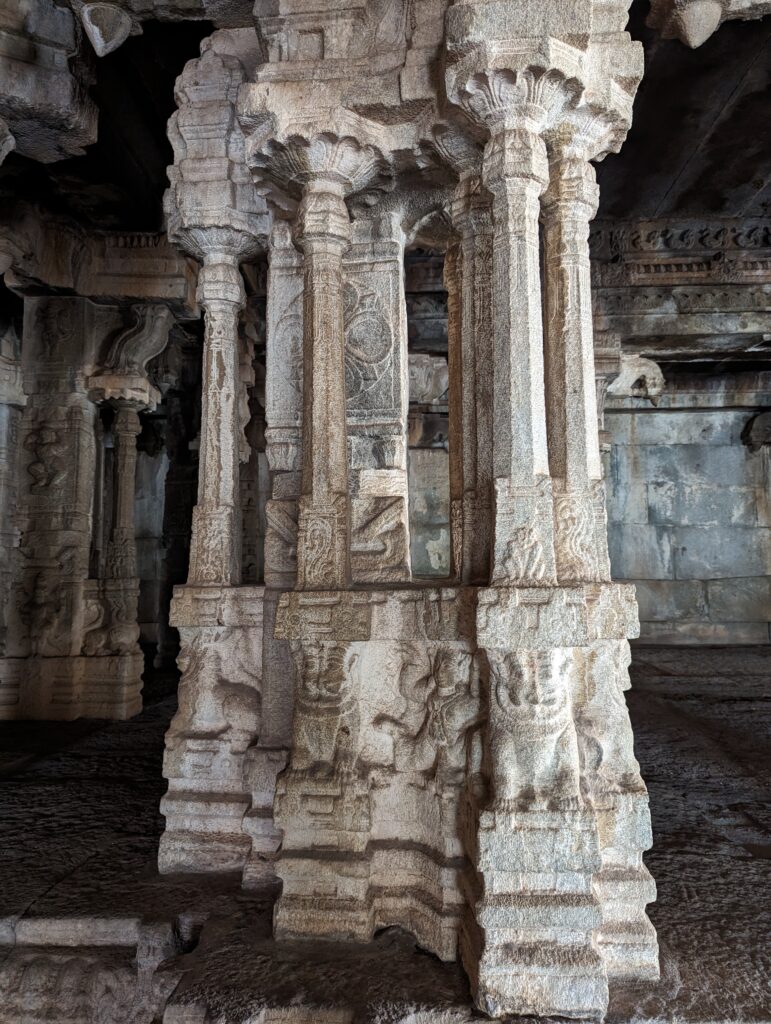
Museum
The museum was better than I anticipated, given Hampi is a relatively small town. It is also a major archeological site… I got to learn about the history and culture of the Vijayanagara Empire, whose capital was Hampi. The explanations were very clear for visitors who are not too versed in Hinduism.
Hazara Rama Temple
Hazara Rama Temple, whose name means ‘a thousand Rama’, is dedicated to Rama, the main protagonist of the epic tale Ramayana. The panels on the walls illustrate scenes of the Ramayana. There are incredibly well-preserved and detailed. I am curious to know what kind of restoration work was done here. The upper parts of the temple (basically the roofs) are not made from the same material and are more damaged. However, the remaining parts are exquisite. They are far more delicate than the panel carvings.
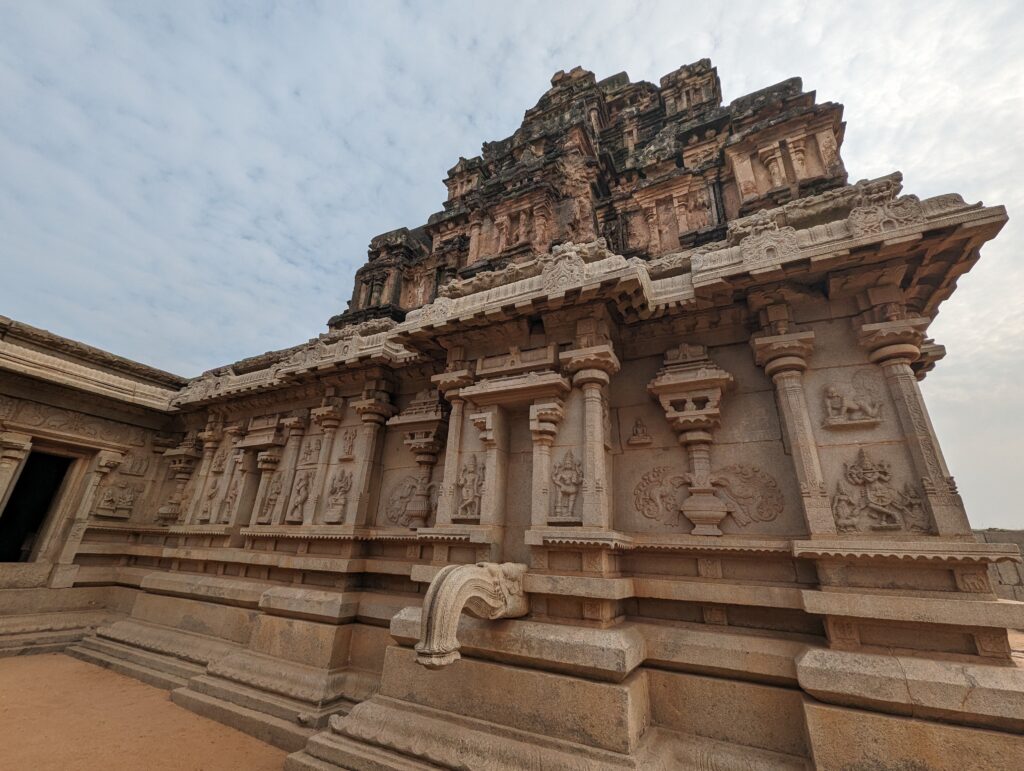
Stepped Water Tank
The stepped tank is part of the temple complex. It was used for religious purposes. It is beautiful, but as it looks more recent than the rest, I wonder what restorations were made.
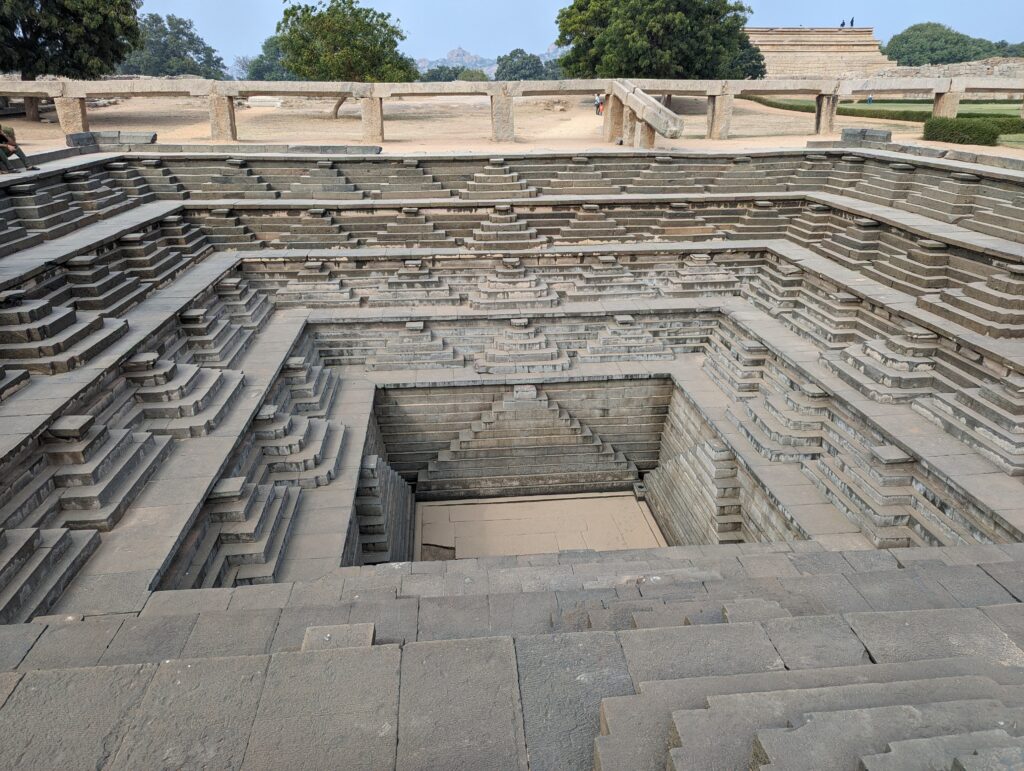
Queen’s Bath
The Queen’s Bath is basically a walled, squared swimming pool for the women of the royal family or for the royal couple. It is interesting to notice the influence of Arabic and Islamic design (Indo-Islamic style) especially because it was built by a Hindu dynasty.
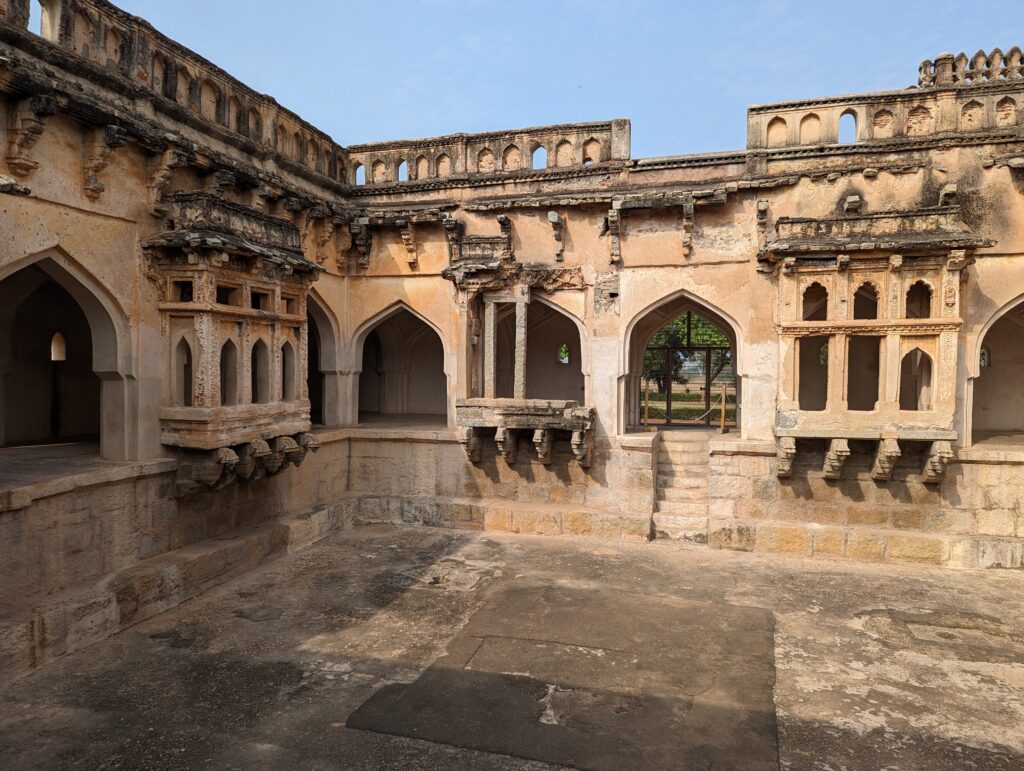
Lotus Mahal
It also has an Indo-Islamic style. There are no more decorations on the walls. And we were not allowed to take pictures, why?

Elephant Stables
There are no more elephants nowadays. But elephants are brought there during ceremonies.

Lakshmi Narashima Temple
Lakshmi Narashima Temple has the largest statue in Hampi. Narashima, part lion (the face), part human, is an avatar of Vishnu. Lakshmi, the goddess of wealth and fortune mainly, was also part of the statue, but her presence has been almost completely erased during the destruction following the fall of Hampi. Next to the statue, there is big Shiva lingam.
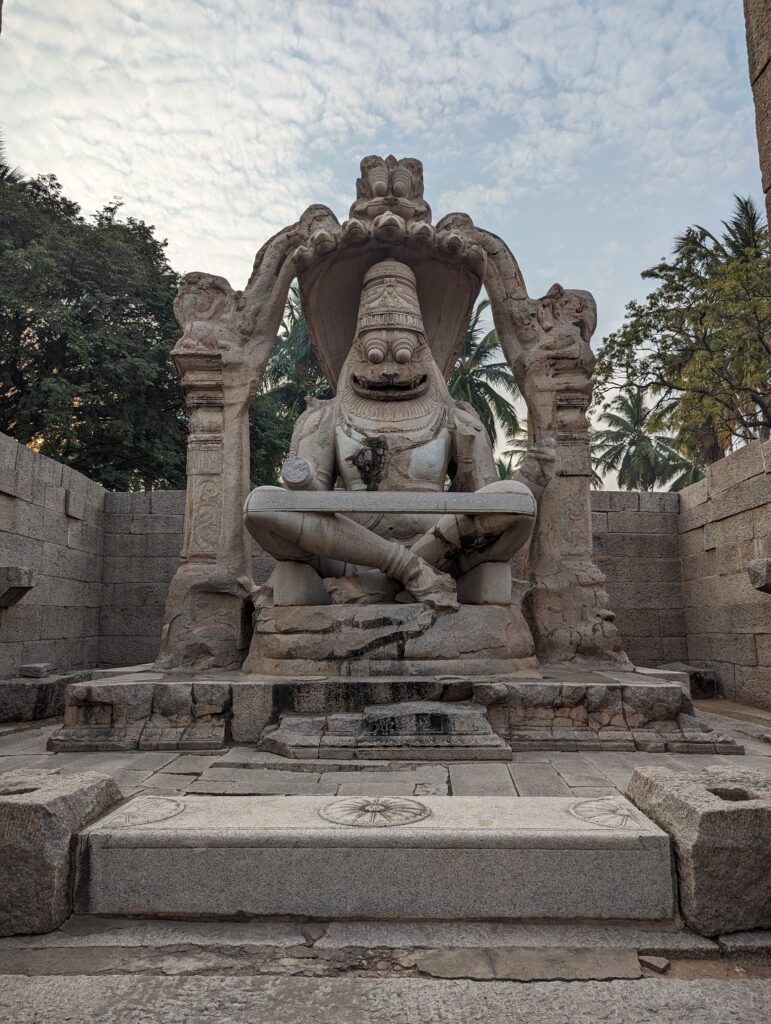
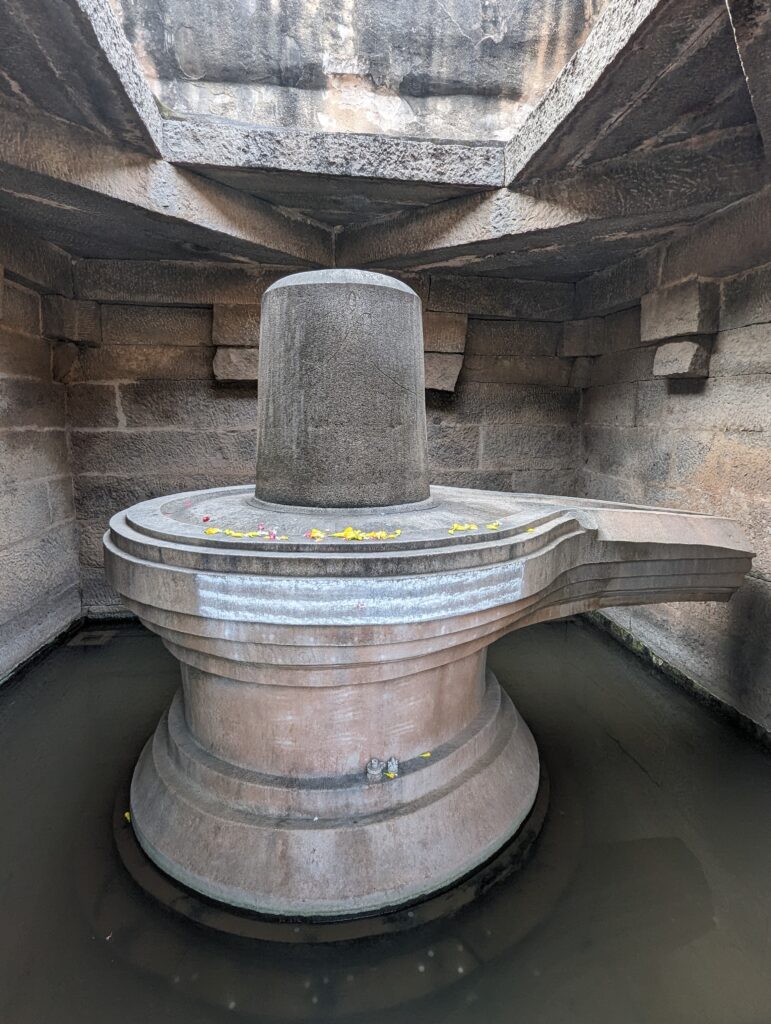
Statue of Ganesh
We passed the statue of Ganesh and climbed to the fort for a sunset view. A monkey (no more than 7 kg) approached a couple with their child and that was sufficient to scare them. They dropped a big bag of banana chips and ran away. The monkey took it and enjoyed just a third of the bag before impressing another group of human to get other type of food. What a bully!

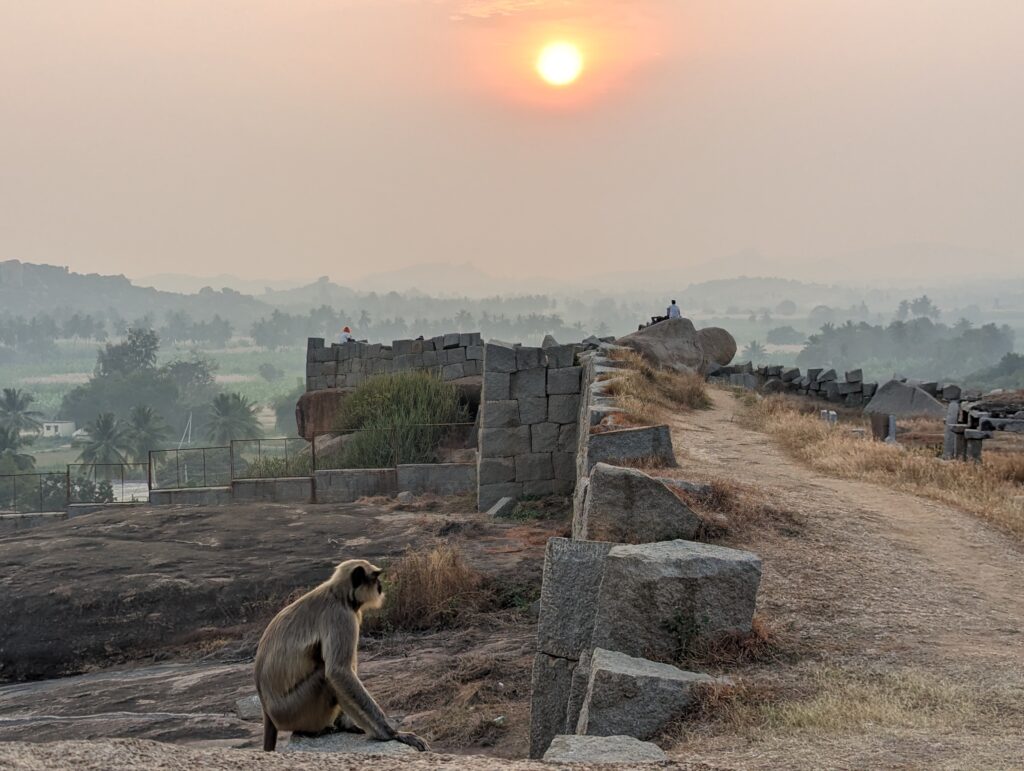
Virupaksha Temple
Nowadays, Virupaksha Temple is a major temple and pilgrimage site in Hampi. It is dedicated to Shiva. And there was a real decorated elephant inside.
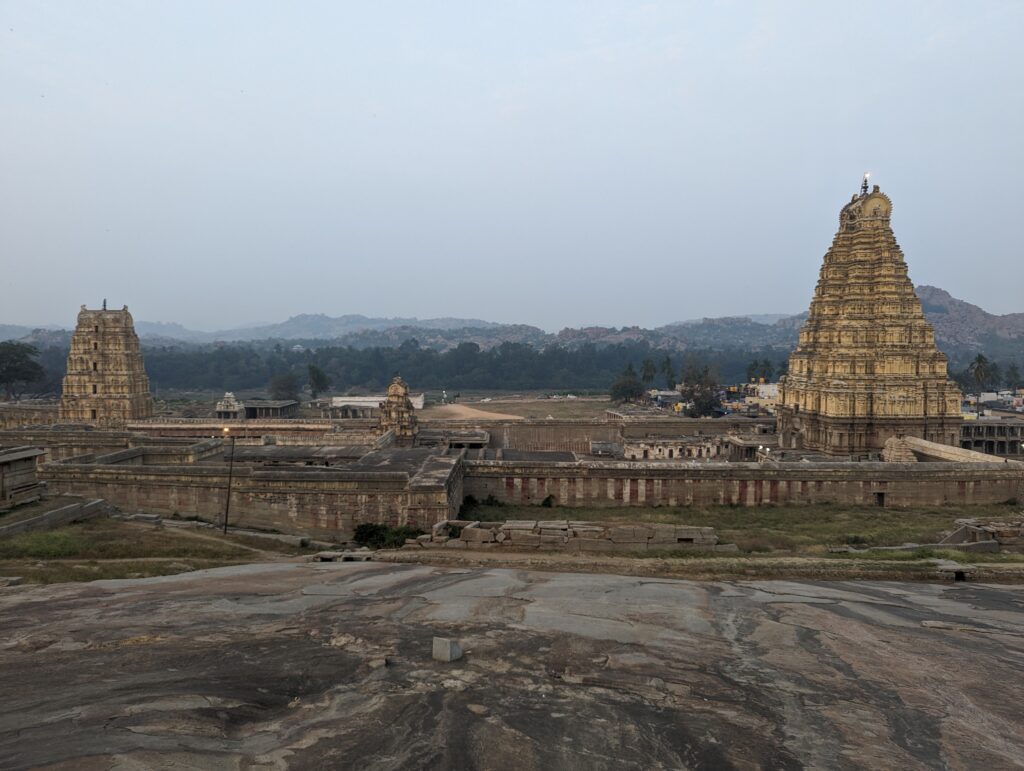

Markets
Markets were located beside the main temples:
— gold and silver at Hampi bazaar next to Virupaksha Temple
— vegetables market next to Krishna temple (Vitthala Temple)
— animals market next to one of Shiva’s temples
— prostitutes at Sule bazar. Not sure if there was a temple next to it.
These details are from Tiger the driver. We could see the markets near the temples, but I could not tell what was traded.
Morning Prayers
The first night, we were woken up at 4 am by many dogs barking loudly, and then we could not go back to sleep because super loud music was playing outside. At around 5:30 am, I went out to address the situation. I realized the city was already partially woken up. The sound was not coming from any houses. I followed the sound until the end of the village at the Hindu temple. There was a ceremony. The loudest speakers were probably in the temple tower. I think there were secondary speakers all along the main road cutting through the village.
We asked the guest house owners if it was a special occasion or if it was happening every day. They laughed and told us it was the same every day. I had the feeling it was louder and longer on the first night. Perhaps it was just because I was surprised.
For the bicycle or motorcycle rentals, they informed us we could pick them up at 7 am (even earlier to secure the motorcycle). That makes a lot more sense now, considering we were going to be awakened early anyway.
The second night, we had placed ear plugs near our pillows. We were woken up by the dogs, who were probably woken up by the music. We managed to sleep with the ear plugs on.
Restaurants
Mango Tree is the popular restaurant in the area. It was crowded for lunch. We ordered the South and the North Thalis. It is a good place to eat, but there is nothing special about it. Many organized tours and tuktuks brought their clients there.
Happy Hampi, a restaurant in the village where we stayed, has delicious starters. The paneer tikka was mouth watering, and the other paneer starters were delicious as well. We went there for every meal except the one during the tour as there was not many options and this one had a local feel.

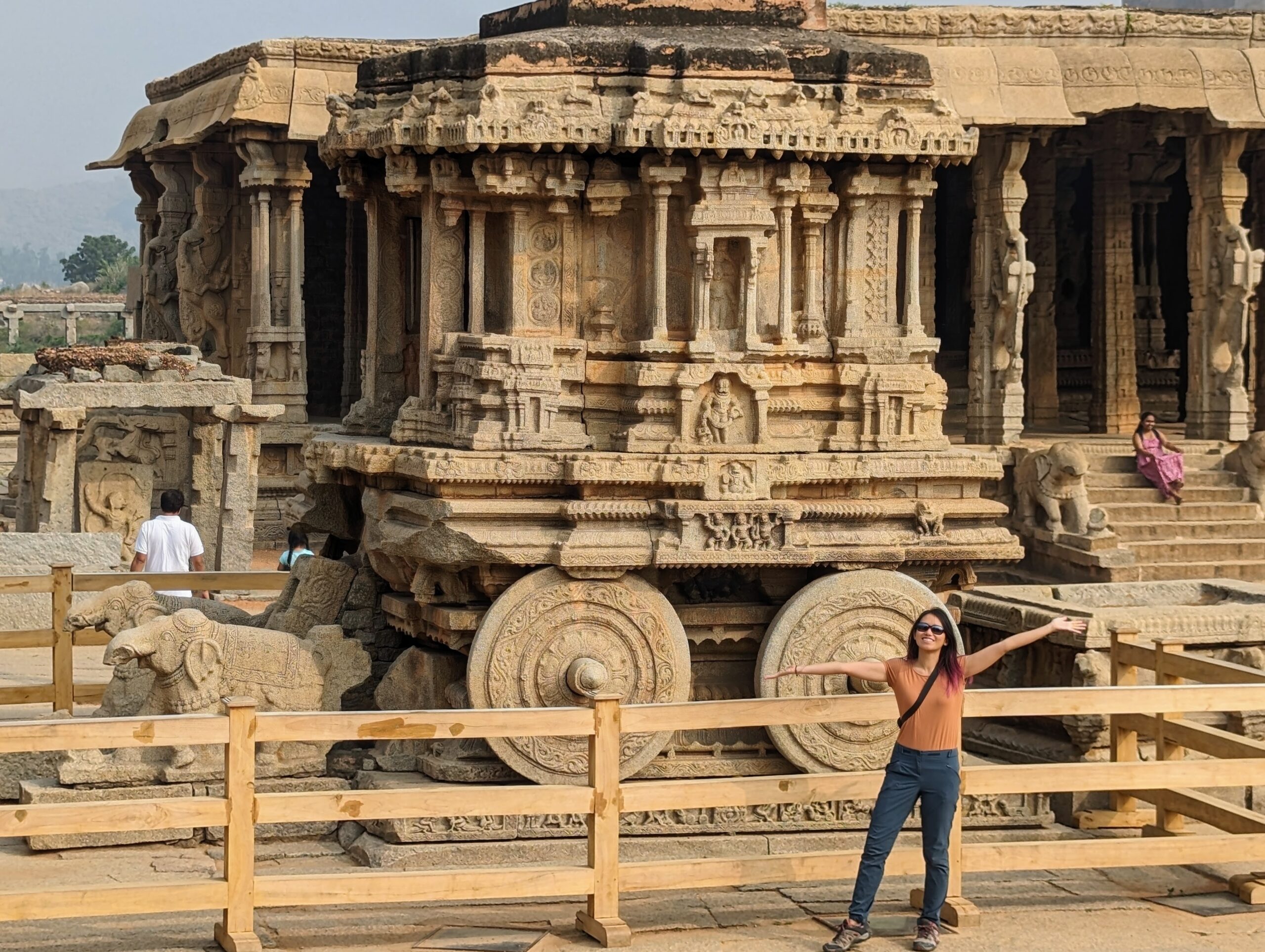
Leave a Reply